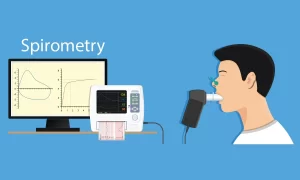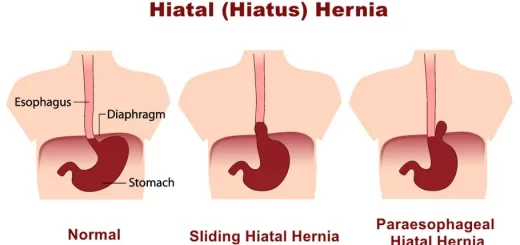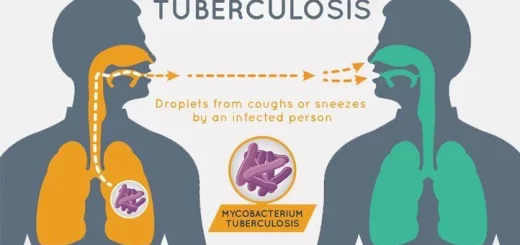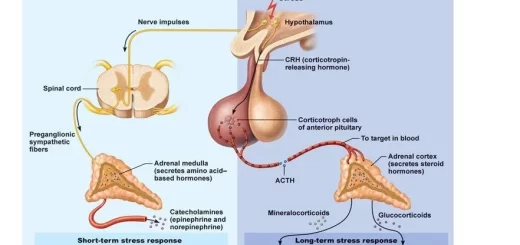Spirometry uses, What is a normal spirometry level? and What is FEV1 in spirometry?
Spirometry is a non-invasive test used to assess lung function, It measures how much air a person can inhale and exhale, as well as how quickly they can exhale, The test is performed using a device called a spirometer, which records the amount (volume) and speed (flow) of air breathed in and out over a specified period.
Spirometry
Spirometry is a pulmonary function test used to assess airflow.
Measurements in Spirometry
- Forced Vital Capacity (FVC) is the maximum amount of air a person can forcefully exhale after taking the deepest breath possible.
- Forced Expiratory Volume in 1 Second (FEV1): The amount of air exhaled during the first second of a forced breath, This is often expressed as a percentage of the total FVC.
- FEV1/FVC Ratio is the ratio of FEV1 to FVC, used to assess airflow obstruction, A low ratio indicates obstructive lung diseases such as asthma or chronic obstructive pulmonary disease (COPD).
- Peak Expiratory Flow (PEF) is the highest speed of air exhaled from the lungs during a forceful breath.
Uses of Spirometry
- Spirometry is essential in diagnosing diseases such as asthma, COPD, and restrictive lung diseases.
- For patients with chronic lung conditions, spirometry helps monitor the effectiveness of treatments.
- Spirometry is used for assessing lung function before surgery, It is used as part of a preoperative evaluation.
Procedure
The patient is instructed to take a deep breath and exhale forcefully into the spirometer as quickly and as long as possible, The test is repeated several times to ensure consistency, The results of spirometry are compared to predicted values based on age, height, sex, and ethnicity to determine if lung function is normal or impaired.
Lung volumes
Tidal volume (TV or Vt): The tidal volume is the total amount of air inhaled or exhaled during normal breathing. On average 500 ml of air is utilized during normal respiration in a healthy man.
Inspiratory reserve volume (IRV); An inspiratory reserve volume is a supplementary volume, ranging between 2500 to 3100 ml of air which could be inhaled effectively after the inspiration of a standard Tidal Volume.
Expiratory reserve volume (ERV): The extra volume of air that can be exhaled from the lungs with effort following a normal tidal volume expiration. An expiratory reserve volume is about 1200 ml that could be forcibly exhaled out after the expiration of a standard tidal volume.
Residual volume (RV): The residual volume is the total volume of air that is around 1100 ml to 1200 ml, residing in the lungs after the reserve volume is exhaled or breathed out. The residual volume functions to keep the alveoli open even after maximum expiration.
Lung capacities
Inspiratory capacity (IC): Tidal volume (TV) + Inspiratory reserve volume (IRV).
Functional residual capacity (FRC): Functional Residual Capacity is the volume remaining in the lungs after a normal exhalation. In a healthy individual, this is about 3L.
Functional residual capacity (FRC) = Expiratory reserve volume (ERV) + Residual volume (RV)
Vital capacity (VC): The vital capacity is the total volume of air that can be breathed out after inhalation limit or maximum air that a person can breathe in after forced expiration. It is an essential measure of a person’s respiratory health. A decreased vital capacity indicates restrictive lung disease where the lungs cannot expand completely. In the general case of normal vital capacity, the improper functioning of the lungs indicates obstructive lung disease, where the lungs are blocked in the airways.
VC= TV + ERV + IRV
Total lung capacity (TLC): The total lung capacity is the total volume of air in the lungs after a forced inspiration. The lung capacity of a healthy man is around 6000 ml.
TLC = TV+ ERV + IRV + RV
With spirometry, all air volumes we inhale and exhale can be recorded. However, this method does not allow the volume of air to be measured which always remains in the lungs after maximum exhalation (residual volume, RV). So, we cannot measure functional residual capacity (FRC) or total lung capacity (TLC) by using spirometry because they depend on residual volume.
Forced vital capacity (FVC)
Forced vital capacity (FVC) is the amount of air that can be forcibly exhaled from your lungs after taking the deepest breath possible. It’s measured by spirometry, which is a common breathing test to check lung function. This test may help distinguish obstructive and restrictive lung diseases.
Normal value = 80% of predicted
Forced expiratory volume in the first second (FEV1)
Forced expiratory volume in the first second (FEV1) is a measurement taken from a pulmonary function test, It calculates the amount of air that a person can force out of their lungs in 1 second.
Normal value = 80% of predicted
FEV1/FVC = 70% of predicted.
Acute respiratory failure
Laboratory hypoxemia in any patient with acute dyspnea or apnea.
How to confirm this hypoxemia on a laboratory bases?
By using Arterial Blood Gases (ABR) → All we find that PO2 < 60mmHg → So the patient has Acute respiratory failure.
You can subscribe to Science Online on YouTube from this link: Science Online
You can download Science Online application on Google Play from this link: Science Online Apps on Google Play
Lung structure, borders, Lobes, Fissures and Broncho-pulmonary segments
Larynx structure, function, cartilage, muscles, blood supply and vocal folds
Anatomy of nose, function of para-nasal air sinuses and Sphenopalatine Ganglion branches
Thoracic vertebrae structure, function, Chest wall muscles and Intercostal arteries
Diaphragm anatomy, structure, function, Phrenic nerves and Nerves of the thorax




